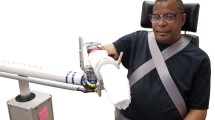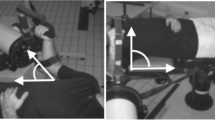Abstract
Biomechanical models used to estimate joint loads often predict that antagonistic muscles are inactive or underestimate their contributions [3, 5]. This can result in systematic underestimation of muscle force predictions and joint contact forces. To test the feasibility of employing an empirical co-activation ratio to improve shoulder muscle force modeling estimates, it was purposed to define the co-activation relationship between humeral internal and external rotator muscles in young healthy adults. Electromyography was recorded from rotator cuff and shoulder musculature of 20 adults. Participants performed 54 submaximal voluntary force exertions of humeral internal and external rotation at various humeral abduction and rotation postures. Empirical co-activation relationships for aggregates of humeral internal and external rotators (non-weighted and PCSA-weighted versions) were well characterized by regression models (r 2 = 0.62–0.70) during internal rotation exertions, but only moderately well (r 2 = 0.35–0.42) during external rotation exertions. Humeral abduction and intensity were important predictors in both exertion types. There was no or minimal improvement in r 2 using PCSA-weighted CIs, suggesting low utility. Quantification and implementation of shoulder co-activation into biomechanical models may improve muscle force and joint load estimates, which could assist in more reliable injury risk and tissue load predictions.


Similar content being viewed by others
References
Basset RW, Browne AO, Morrey BT, An K-N (1990) Glenohumeral muscle force and moment mechanics in a position of shoulder instability. J Biomech 23:405–415
Brookham RL, Middlebrook E, Grewal T, Dickerson CR (2011) The utility of an empirically derived co-activation ratio for muscle force prediction through optimization. J Biomech 44(8):1582–1587
Collins JJ (1995) The redundant nature of locomotor optimization laws. J Biomech 28:251–267
Cram JR, Kasman GS (1998) Introduction to surface electromyography. Aspen Publications, Alexandria
Crowninshield RD, Brand RA (1981) A physiologically based criterion of muscle force prediction in locomotion. J Biomech 14(11):793–801
Dickerson CR (2008) Modeling and Simulation of Tissue Load. In: Hong Y, Bartlett R (eds) Routledge handbook of biomechanics and human movement science. Routledge, New York, pp 18–34
Doheny EP, Lowery MM, Fitzpatrick DP, O’Malley MJ (2008) Effect of elbow joint angle on force-EMG relationships in human elbow flexor and extensor muscles. J Electromygr Kinesiol 18(5):760–770
Drake J, Callaghan JP (2006) Elimination of electrocardiogram contamination from electromyogram signals: an evaluation of currently used removal techniques. J Electromygr Kinesiol 16:175–187
Geiringer SR (1999) Anatomic localization for needle electromyography, 2nd edn. Hanley & Belfus, Inc Gottlieb, Philadelphia
Granata KP, Wilson SE, Massimini AK, Gabriel R (2004) Active stiffness of the ankle in response to inertial and elastic loads. J Electromygr Kinesiol 14:599–609
Harryman DT, Sidles JA, Harris SL, Matsen FA (1992) Laxity of the normal glenohumeral joint: a quantitative in vivo assessment. J Shoulder Elbow Surg 1(2):66–76
Hughes RE, Chaffin DB (1988) Conditions under which optimization models will not predict coactivation of antagonistic muscles. Proc Am Soc Biomech 12:69–70
Itoi IE, Morrey BR, An K-N (2009) Biomechanics of the Shoulder. In: Rockwood CA, Matsen FA, Wirth MA, Lippitt SB (eds), Fehringer EV, Sperling JW (assoc eds) The Shoulder, vol 1, 4th edn. Saunders, Philadelphia, pp 213–250
Kellis E, Arabatzi F, Papadopoulos C (2003) Muscle co-activation around the knee in drop jumping using the co-contraction index. J Electromygr Kinesiol 13:220–238
Kingma I, Aalbersherg S, van Dieen JH (2004) Are hamstrings activated to counteract shear forces during isometric knee extension efforts in healthy subjects? J Electromygr Kinesiol 14(3):307–315
Lee PJ, Rogers EL, Granata KP (2006) Active trunk stiffness increases with co-contraction. J Electromygr Kinesiol 16:51–57
Lee S-B, Kim K-J, O’Driscoll SW, Morrey BF, An K-N (2000) Dynamic glenohumeral stability provided by the rotator cuff muscles in the mid-range and end-range of motion. J Bone Joint Surg 82-A(6):849–857
McKernan DJ, Mutschler TA, Rudert MJ et al (1990) The characterization of rotator cuff muscle forces and their effect on glenohumeral joint stability: a biomechanical study. Orthop Trans 14:237–238
Middlebrook EE, Brookham RL, Dickerson CR (2011) Extrapolation of an empirical elbow muscle co-activation relationship to a novel task set: implications for predictions of individual muscle demands. Comput Methods Biomech Biomed Eng (in press). Identifier GCMB-2011-0165, 22 Dec 2011
Nemeth G, Krongberg M, Brostrom L (1990) Electromyogram (EMG) recordings from the subscapularis muscle: description of a technique. J Orthop Res 8:151–153
Praagman M, Chadwick E, van der Helm F, Veeger H (2010) The effect of elbow angle and external moment on load sharing of elbow muscles. J Electromygr Kinesiol 20:912–922
Solomonow M, Guzzi A, Baratta R, Shoji H, D’Ambrosia D (1986) EMG-force model of the elbow antagonistic muscle pair: the effect of joint position, gravity and recruitment. Am J Phys Med 66(5):223–242
van der Helm F (1994) A finite element musculoskeletal model of the shoulder mechanism. J Biomech 27(5):551–569
Veeger H, van der Helm F, van der Woude L, Pronk GM, Rozendal RH (1991) Inertia and muscle contraction parameters for musculoskeletal modelling of the shoulder mechanism. J Biomech 7:615–629
Winter DA (2009) Biomechanics and motor control of human movement, 4th edn. Wiley, New Jersey
Zajac FE, Gordon ME (1989) Determining muscle’s force and action in multiarticular movement. Exer Sport Sci Rev 17:187–230
Acknowledgments
The following sources are acknowledged for financial support: Natural Science and Engineering Research Council, Canada Foundation for Innovation, and the University of Waterloo.
Author information
Authors and Affiliations
Corresponding author
Rights and permissions
About this article
Cite this article
Brookham, R.L., Dickerson, C.R. Empirical quantification of internal and external rotation muscular co-activation ratios in healthy shoulders. Med Biol Eng Comput 52, 257–264 (2014). https://doi.org/10.1007/s11517-013-1081-2
Received:
Accepted:
Published:
Issue Date:
DOI: https://doi.org/10.1007/s11517-013-1081-2




